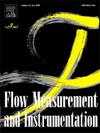An approach to solving the influence of high solids holdup ring and background in fluidized bed on electromagnetic tomography
IF 2.3
3区 工程技术
Q2 ENGINEERING, MECHANICAL
引用次数: 0
Abstract
The electromagnetic tomography (EMT) technology based on tunneling magneto resistance (TMR) can efficiently detect phase distributions in the gas-liquid-solid fluidized bed by the difference of permeability. The solid clusters and bubble clusters are distributed within the background formed by the mixture of three phases, while the solids gather near the pipe wall and form a high solids holdup ring. Since the boundary measurement data obtained by the TMR-EMT system are significantly influenced by the background and ring, it is difficult to reconstruct the cluster distribution directly with the raw data. In order to improve the reconstruction quality, a method to weaken the influence of the background and ring is proposed. Based on the equivalent magnetic circuit model, the ring permeability is estimated and the Ring model is established. Combining the virtual reference field (VRF) model and the Ring model, the virtual reference field with the high solids holdup ring (VRF-R) model is established. Using the VRF-R model to process the boundary measurement data, the quality of the cluster distribution reconstruction is improved greatly. Compared with VRF, the correlation coefficient of VRF-R increases from 0.52 to 0.77 (in simulation) and 0.50 to 0.73 (in experiment), respectively.
一种解决流化床高固含环和本底对电磁层析成像影响的方法
基于隧道磁阻(TMR)的电磁层析成像(EMT)技术可以通过磁导率的差异有效地检测气液固流化床中的相分布。固体团簇和气泡团簇分布在三相混合形成的背景内,固体团簇聚集在管壁附近,形成高固含率环。由于TMR-EMT系统获得的边界测量数据受背景和环的影响较大,直接利用原始数据重建聚类分布比较困难。为了提高重建质量,提出了一种减弱背景和环的影响的方法。在等效磁路模型的基础上,估算了环磁导率,建立了环模型。将虚拟参考场(VRF)模型与环模型相结合,建立了具有高固含率环(VRF- r)模型的虚拟参考场。利用VRF-R模型对边界测量数据进行处理,极大地提高了聚类分布重构的质量。与VRF相比,VRF- r的相关系数分别从0.52增加到0.77(模拟)和0.50增加到0.73(实验)。
本文章由计算机程序翻译,如有差异,请以英文原文为准。
求助全文
约1分钟内获得全文
求助全文
来源期刊

Flow Measurement and Instrumentation
工程技术-工程:机械
CiteScore
4.30
自引率
13.60%
发文量
123
审稿时长
6 months
期刊介绍:
Flow Measurement and Instrumentation is dedicated to disseminating the latest research results on all aspects of flow measurement, in both closed conduits and open channels. The design of flow measurement systems involves a wide variety of multidisciplinary activities including modelling the flow sensor, the fluid flow and the sensor/fluid interactions through the use of computation techniques; the development of advanced transducer systems and their associated signal processing and the laboratory and field assessment of the overall system under ideal and disturbed conditions.
FMI is the essential forum for critical information exchange, and contributions are particularly encouraged in the following areas of interest:
Modelling: the application of mathematical and computational modelling to the interaction of fluid dynamics with flowmeters, including flowmeter behaviour, improved flowmeter design and installation problems. Application of CAD/CAE techniques to flowmeter modelling are eligible.
Design and development: the detailed design of the flowmeter head and/or signal processing aspects of novel flowmeters. Emphasis is given to papers identifying new sensor configurations, multisensor flow measurement systems, non-intrusive flow metering techniques and the application of microelectronic techniques in smart or intelligent systems.
Calibration techniques: including descriptions of new or existing calibration facilities and techniques, calibration data from different flowmeter types, and calibration intercomparison data from different laboratories.
Installation effect data: dealing with the effects of non-ideal flow conditions on flowmeters. Papers combining a theoretical understanding of flowmeter behaviour with experimental work are particularly welcome.
 求助内容:
求助内容: 应助结果提醒方式:
应助结果提醒方式:


